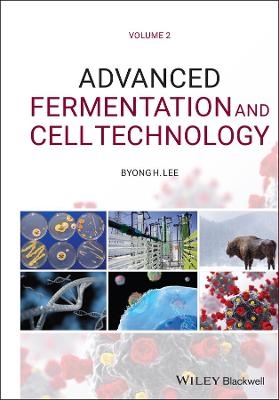
Advanced Fermentation and Cell Technology
Wiley-Blackwell (Verlag)
978-1-119-04276-1 (ISBN)
Fermentation and cell culture technologies encompass more than the conventional microbial and enzyme systems used in the agri-food, biochemical, bioenergy and pharmaceutical industries. New technologies such as genetic engineering, systems biology, protein engineering, and mammalian cell and plant cell systems are expanding rapidly, as is the demand for sustainable production of bioingredients, drugs, bioenergy and biomaterials. As the growing biobased economy drives innovation, industrial practitioners, instructors, researchers, and students must keep pace with the development and application of novel fermentation processes and a variety of cell technologies.
Advanced Fermentation and Cell Technology provides a balanced and comprehensive overview of the microbial, mammalian, and plant cell technologies used by the modern biochemical process industry to develop new and improved processes and products. This authoritative volume covers the essential features of advanced fermentation and cell technology, and highlights the interaction of food fermentation and cell culture biopharmaceutical actives. Detailed chapters, organized into five sections, cover microbial cell technology, animal and plant cell technology, safety issues of new biotechnologies, and applications of microbial fermentation to food products, chemicals, and pharmaceuticals. Written by an internationally-recognized expert in food biotechnology, this comprehensive volume:
- Covers both conventional and novel industrial fermentation technologies and their applications in a range of industries
- Discusses current progress in novel fermentation, cell culture, commercial recombinant bioproducts technologies
- Includes overviews of the global market size of bioproducts and the fundamentals of cell technology
- Highlights the importance of sustainability, Good Manufacturing Practices (GMP), quality assurance, and regulatory practices
- Explores microbial cell technology and culture tools and techniques such as genome shuffling and recombinant DNA technology, RNA interference and CRISPR technology, molecular thermodynamics, protein engineering, proteomics and bioinformatics, and synthetic biology
Advanced Fermentation and Cell Technology is an ideal resource for students of food science, biotechnology, microbiology, agricultural sciences, biochemical engineering, and biochemistry, and is a valuable reference for food scientists, researchers, and technologists throughout the food industry, particularly the dairy, bakery, and fermented beverage sectors.
Dr Byong H. Lee, Scientific Advisor at SportBiomics, CA, USA; Former Distinguished Professor at Kangwon National University (Department of Food Science and Biotechnology), Chuncheon, South Korea; Former Distinguished Professor at Jiangnan University (School of Biotechnology), Wuxi, China; Former Professor (AAFC Chair) and Affiliated Professor at McGill University (Departments of Microbiology/Immunology and Food Science/Agricultural Chemistry) and Principal Research Scientist /Head of Biotechnology at Agriculture and Agri-Food Canada, Quebec, Canada.
Preface
Overview on Market Size of Bioproducts and Fundamentals of Cell Technology
Biotechnology and global market size of bioproducts
Cellular organization and membrane structure of three domains
Part I
Chapter 1 Microbial Cell Technology
1.1 Basic bacterial growth and mode of fermentation
1.2 Basic fungal growth
1.3 Classical strain improvements and tools
1.3.1 Natural selection and mutation
1.3.2 Recombination
1.4 Modern strain improvement and tools
1.4.1 Genome shuffling
1.4.2 Recombinant DNA technology
1.4.3 RNA interference (RNAi) and CRISPR)/Cas technology for genome editing
1.4.3.1 RNA interference (RNAi)
1.4.3.2 CRISPR)/Cas technology for genome editing
1.4.4 Molecular thermodynamics for biotechnology
1.4.5 Protein engineering
1.4.6 Genomics, proteomics and bioinformatics
1.4.7 Systems/synthetic biology and metabolic engineering
1.4.8 Quorum sensing and quenching
1.5 Bioengineering and scale-up process
1.5.1 Microbial and process engineering factors affecting performance and economics
1.5.2 Fermenter and bioreactor systems
1.5.3 Mass transfer concept
1.5.4 Heat transfer concept
1.5.5 Mass and heat transfer practice
1.5.6 Scale-up and scale-down of fermentations
1.5.6.1 Scale-up methods
1.5.6.2 Bioinstrumentation and computer control
1.3.6.3 Physical measurement
1.5.6.4 Chemical measurement
1.5.6.5 Biological measurement
1.5.6.6 Computer applications
1.5.6.7 Process control
1.5.6.8 SCADA control system
1.5.7 Scale-up challenges
1.6 New bioprocesses of fermentation
1.6.1 Growth-arrested bioprocess
1.6.2 Integrated bioprocess
1.6.3 Consolidated bioprocessing (CBP)
Summary
Bibliography
Part II
Chapter 2 Applications of Microbial Fermentation to Food Products, Chemicals and Pharmaceuticals
2.1 Fermented dairy products
2.1.1 Basic knowledge of manufacture of dairy products
2.1.2 Genetic engineering of lactic acid bacteria
2.2 Fermented meat and fish products
2.2.1 Fermented meat products
2.2.2 Fermented fish products
2.3 Fermented vegetable and cereal products
2.3.1 Fermented vegetable products
2.3.2 Fermented cereal products
2.4 Organic acids
2.4.1 Acetic acid
2.4.2 Citric acid
2.4.3 Lactic acid
2.4.4 Malic acid
2.4.5 Fumaric acid
2.5 Flavors and Amino acids
2.5.1 Microbial flavors
2.5.2 Amino acids
2.6 Sweeteners
2.5.1 Nutritive sweeteners
2.5.2 High intensity sweeteners
2.7 Vitamins and Pigments
2.7.1 Production of vitamins
2.7.2 Production of pigments
2.8 Microbial polysaccharides and Biopolymers
2.8.1 Microbial polysaccharides
2.8.2 Biopolymers
2.9 Bacteriocins and Bacteriophages
2.9.1 Bacteriocins
2.9.2 Bacteriophage
2.10 Enzymes
2.11 Biomass (SCP) and Mushrooms
2.11.1 Biomass (SCP)
2.11.2 Mushrooms
2.12 Functional foods and Nutraceuticals
2.12.1 Probiotics and prebiotics
2.12.2 Microbiome
2.13 Alcoholic beverages
2.13.1 Beer
2.13.2 Wine
2.14 Other fermentation chemicals
2.14.1 Bioethanol
2.14.2 Biobutanol
2.14.3 Biobutanediol
2.14.4 Biodiesel
2.14.5 Biomethane
2.14.6 Biohydrogen
2.15 Pharmaceuticals, Growth promoters, and Biopesticides
2.15.1 Antibiotics
2.15.2 Antibiotic (or Antimicrobial) growth promoters (AGPs)
2.15.3 Antitumor drugs
2.15.4 Steroids
2.15.5 Statins
2.15.6 Biopesticides
Summary
Bibliography
Part III
Chapter 3
3.1 Animal Cell Technology
3.1.1 Introduction
3.1.2 Techniques of RNAi and CRISPR
3.1.3 Animal cell lines
3.1.3.1 Anchorage-dependent (adherent) cells
3.1.3.2 Anchorage-independent (suspension) cells
3.1.4 Upstream and downstream bioprocessing
3.1.5 Strain development of animal cell cultures
3.1.6 Applications of animal cell cultures
3.1.6.1 Monoclonal antibodies (mABs)
3.1.6.2 Vaccines
3.1.6.3 DNA vaccines
3.1.6.4 Reverse vaccinology (RV)
3.1.6.5 Edible vaccines
3.1.6.6 Zika vaccines
3.1.6.7 Hepatitis vaccines
3.1.6.8 HIV vaccines
3.1.7 Transgenic animal bioreactors
3.2.7.1 Introduction and techniques
3.2.7.2 Applications of transgenic animals
Part IV
Chapter 4 Plant Cell Technology
4.1 Introduction
4.2 Plant tissue culture
4.3 Applications of plant tissue culture
4.3.1 Traditional plant breeding (Non-recombinant DNA techniques)
4.3.2 General media for plant tissue culture
4.3.3 Bioreactor types of plant cell cultures
4.3.3.1 Seed based bioreactor
4.3.3.2 Plant cell suspension bioreactor
4.3.3.3 Hairy root bioreactor
4.3.3.4 Chloroplast bioreactors
4.3.4 Modern plant breeding or Biotech/GM crops (Recombinant DNA Techniques)
4.3.4.1 Agricultural applications
Summary
Bibliography
Part V
Chapter 5. Safety Issues of New Biotechnologies on Microbial, Animal, and Plant Cells
5.1 Introduction
5.2 Safety evaluation of novel foods and cell culture products
5.2.1 Genetically Modified Microorganisms and Their Products
5.2.2 Genetically Modified Animal Cell Cultures, Animals, Fishes and Their Products
5.2.2.1 Safety aspects of animal cell culture
5.2.2.2 Genetically modified animals and their products
5.2.2.3 Detection methods of transgenic animals and fishes
5.2.3 Genetically Modified Plants and Their Products
5.2.3.1 Whole GM crops
5.2.3.2 Safety concern of GM crops and cell cultures
5.2.3.3 Safety of GM crops- and GMM derived ingredients
5.3.3.4 Detection methods of GM crops
Summary
Bibliography
Index
| Erscheinungsdatum | 07.10.2019 |
|---|---|
| Verlagsort | Hoboken |
| Sprache | englisch |
| Maße | 170 x 244 mm |
| Gewicht | 2114 g |
| Einbandart | gebunden |
| Themenwelt | Naturwissenschaften ► Biologie |
| Naturwissenschaften ► Chemie | |
| Technik | |
| ISBN-10 | 1-119-04276-3 / 1119042763 |
| ISBN-13 | 978-1-119-04276-1 / 9781119042761 |
| Zustand | Neuware |
| Informationen gemäß Produktsicherheitsverordnung (GPSR) | |
| Haben Sie eine Frage zum Produkt? |
aus dem Bereich


